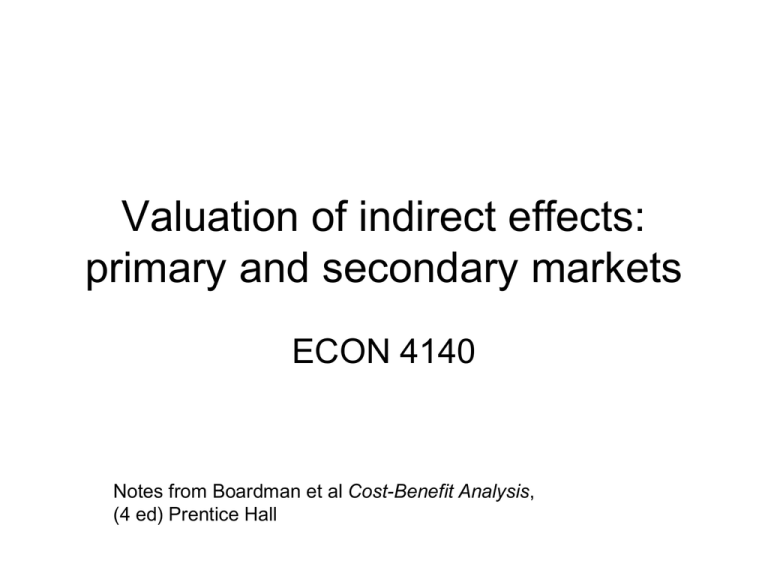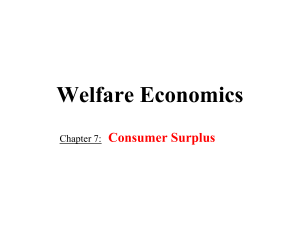Indirect Effects Valuation: Primary & Secondary Markets
advertisement

Valuation of indirect effects: primary and secondary markets ECON 4140 Notes from Boardman et al Cost-Benefit Analysis, (4 ed) Prentice Hall The issue • In principle, for every primary market - the sector with the intervention (e.g., transportation, health, recreation) there may be one or more secondary markets that experience positive or negative effects. – Development of a recreational fishery in a park may stimulate the demand for sports supplies, sales of boats, hotels, guide services, etc. – Using pharmacies for vaccination can stimulate collateral sales – Transit improvements will change land values (rising close to stations) and perhaps falling (relatively further away). • Partial equilibrium often uses a primary/secondary market model to trace the impact of investments • In principle, many secondary markets exist… in practice CBA only tracks those with the largest measureable net impact • A computable general equilibrium model is ideal, but very costly (data and model intensive) (see Layman article under Lecture 5) Partial equilibrium analysis • All primary market effects must be included • Secondary effects can be ignored when the when the marginal social benefit equals the marginal social cost. • This typically occurs when secondary markets are competitive – The purchases in the primary market will not alter supply, and therefore will not change prices. – If the project is small, secondary impacts will also be small, and can usually be ignored • Usually, a few secondary markets can be identified, analyzed sequentially and summed as a group. • A key challenge is to avoid double counting – Transit improvements will lower travel time (cost) and also result in changes in land values (count only 1) – Vaccination reduces time lost from work (measured as the avoided time lost multiplied by the wages) and increased produce of producers. Special case: sometimes it is hard to value a primary effect, and we may need to resort to measurement of the corresponding secondary effects. Valuation in secondary markets (complements) – efficient markets Primary markets are directly affected by the program/policy (hiring of labour, materials..) Secondary markets are indirectly affected by the policy/program. Example: Stocking the nearby lake with fish lowers marginal cost and number of days fishing increases with an increase in social surplus. Price for fishing falls to PF1 (primary market) and this raises demand in the fishing equipment market (DE0 to DE1) • Under efficient secondary markets (competition), price will not rise, and producer surplus is not affected. • But consumer surplus increases in the secondary market, which we cannot count since it has already been measured in the primary market • We cannot count the increase in the primary and secondary markets… • … as long as prices do not rise in the secondary market. We can ignore secondary markets when we measure all primary impacts and prices in secondary markets do not change as a result of the program/policy/project. Ps Pp Po ΔP S a b D1 D0 0 ΔX Xp 0 X0 Xs Valuation in secondary markets (substitutes) – upwars sloping secondary supply Primary market (Fishing) Secondary market (Golf) • The increase in demand for fishing days raises surplus by PF0abPF1 (initially) • If fishing and golf are substitutes, the demand for golfing will fall and green fees for golfing will fall. • The falling price of green fees increases consumer surplus (PG0efPG1) • In turn, the lower green fees with reduce the demand for fishing (DF0 DF1) \ • D* shows the observed demand and represents a lower consumer surplus associated with the increase in fish stocks because of the reaction in the golf market. Consumer surplus in the primary market is PFIacPF1. • The argument is tricky since the two figures show a series of interactions over time. Therefore, D* is the curve more likely to be used in a CBA. This curve, however, understates the true measure of the gain in social surplus in the primary market. But this understatement is a close approximation of the net loss of social surplus in secondary markets due to price changes. Indirect Effects T t 1 n ( pij cij )( x1 jt x0 jt ) ( pij cij )( x1 jt x0 jt ) / (1 i)t j 1 The first term in the numerator (pij-xij) is the difference of price and marginal cost in the primary market; the second term is the change in quantity produced in the secondary market as a result of the changed demand from the primary market. This change can be positive or negative. ( p c)( x1 x0 ) ( p c)(x) Valuation in distorted secondary markets When market failure creates a divergence of private and social cost, valuation impacts in secondary markets is tricky. EXTERNALITY These distortions appear as a hidden extra cost over price. In a competitive secondary market the horizontal supply rises The increase in the indirect demand for equipment creates a total cost of the change in price (x) times the change in demand (qE0 – qE1). Imagine the equipment comprises lead sinkers that end up contaminating the lake. The cost of the externality (lead in the lake) should be subtracted from the net benefits of the project. This appears as the shaded area Effect of taxes on substitutes • Beef Chicken • • • • • • • Beef (primary) and chicken (secondary) are substitutes. (Asymmetric substitution) In equilibrium, assume PB and PC are the relevant prices and demand DB0 and DC0 for beef and chicken respectively First , if there is an existing tax on chicken of tc → price rises to P+tc yielding revenue of T for the government and T+U in loss of consumer surplus for chicken eaters. Note deadweight loss of U. Second, if beef is now taxed by tB , price of beef rises and the demand for chicken rises, reducing consumer surplus by A+B The deadweight loss in the chicken market is now U+V The shift in chicken demand is not an increase in consumer surplus in the secondary market. All the change in surplus occurs in the primary market, while tax revenues increase in both markets. You need to start with a designation of primary and secondary markets. Boardman, A. et al Cost-benefit analysis, concepts and practice, (4ed) Prentice Hall, p.124







